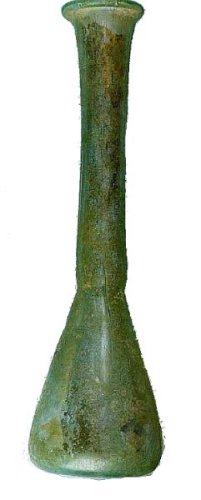|
|
Glass Flask at Abingdon: 2nd century AD |

Fine glass vessels were probably never made in Roman Britain, but were imported from the Rhineland. Finds of whole glass vessels are relatively rare, and usually come from Roman graves.
Two types of glass container are frequently found together in Roman cremation graves, the "cinerary" vessel (squat, with a narrow neck and single handle) used to hold the ashes, and the green glass unguent flasks with perfumed oil for anointing the body. Both men and women used perfumed oil after bathing, so the flask may have belonged to either; and dead bodies were also perfumed. The Bible describes many of these perfumings, as when Mary Magdalen anoints Jesus’ feet, and when the two Marys go to perfume the body of Jesus.
This earlier, longer-necked form of flask, with triangular body, was replaced by different forms in the 3rd and 4th centuries.
© 1998 Oxfordshire Museum Service, Setúbal Museums and the Benaki Museum